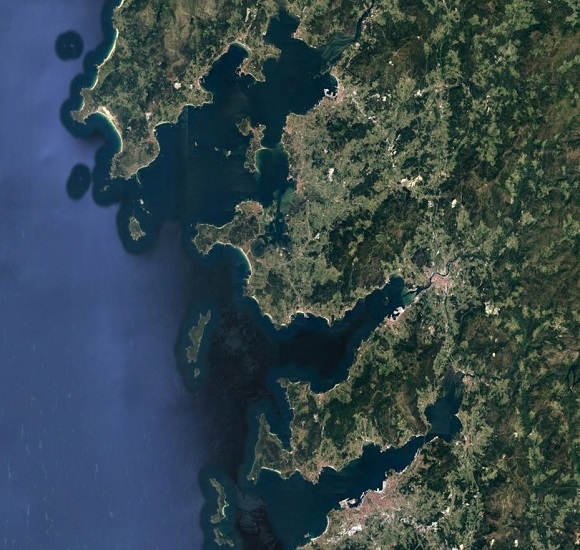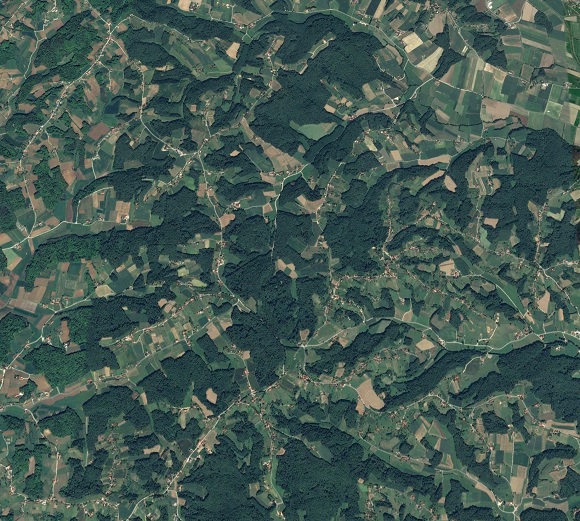Fractal life
Fractals fascinate everyone who sees them. Why do we feel this sensation? And why do we often find them in nature?
![]()
For Teresa.
Fractals enjoy a certain charming for their aesthetics derived from regularity hidden under a seemingly irregular pattern. Actually, fractals are mathematical objects placed on the Mathematics agenda by Mandelbrot, who baptized them in 1975 —though mathematicians had been working on them since the beginning of the 20th century. This summer, in an presentation performed in the wonderful Pyrenean environment of Farrera Centre d'Art i Natura, the mathematician Francesc Mañosas defined them by two properties: self-similarity at different scales and complex geometry. This complexity can be estimated by means of an indicator, the so-called fractal dimension. A cube is a 3-dimensional mathematical object with exact self-similarity at a different scale —in fact, mathematicians recognize different types of more or less perfect self-similarity— because if we reduce by half each cube's side we obtain 8 identical smaller cubes. Since we are in three dimensions, we must raise the reduction factor of each side, 2, to dimension 3 to obtain the eight cubes that complete the initial cube in a self-similar way. The fractal dimension can be expressed as the power at which the factor that determines the reduction or scale is raised - in our example, 2 - to reproduce the same form on a larger scale (23 = 8). But a cube is a regular geometric object, with a fractal dimension of 3: it is not very complex, it would not be a fractal itself. In fractals, that dimension is not a whole number, which shows its complex nature. The closer you get to that whole number, the more complete the packing of the lower dimension shape, as a surface that is 2-dimensional, in the shape of the upper dimension, in our case a volume, which is 3-dimensional.

The great attraction of fractals is that they reproduce quite well physical entities that we find in nature. Some of them, like electromagnetic waves, are used continuously, although they are not visible. In fact, the properties of fractals have been applied to the design of objects as useful as the antennas of cars and mobiles. But fractals have an undoubted aesthetic effect because of that combination of irregularity within a pattern. As the cellist Gabrielle Deakin suggested in the aforementioned meeting in the Pyrenees, humans are fascinated by the subtle surprises that provide different interpretations of a predictable musical landscape, prefixed in a score by J. S. Bach. We are conscious living beings that seek control of the environment, without surprises that are frequently hostile, for example, in the form of predators or accidents. But we appreciate those variations that enrich our diet, the genetic cross-fertilization of our descendants thanks to loving encounters with members of other groups, and ultimately our experiences and memories. Once again, we find sense in the combination between repetition and rarity that characterizes life, something that call biodiversity.

Fractals have been widely used in visual, powerful design. In addition to abstract forms that reproduce patterns and variations, we wonder at their ability to recreate forms found in nature, such as snowflakes, shorelines, ramifications of roots or tree branches. For this reason, in the digital environments of films fractals are used to construct landscapes and scenography from algorithms. They are a beautiful example of the connection between mathematics and nature. But a rational mind is not satisfied to only contemplate patterns, without understanding of the causes. Science is characterized by the critical search for the comprehension of the world through the testing of hypotheses against empirical or experimental observations. The physicist Jorge Wagensberg was thoroughly engaged to explain why we find a series of widely extended geometric forms in nature, such as the sphere, the hexagon, the angle, the wave, the parabola, the spiral, the helix, and the fractals. According to Wagensberg, fractal forms represent a way to intensively explore the environment, in particular by biological entities. It makes sense, but it remains as a descriptive explanation in which we can think a bit more.
Fractals have been widely used in visual, powerful design. In addition to abstract forms that reproduce patterns and variations, we wonder at their ability to recreate forms found in nature, such as snowflakes, shorelines, ramifications of roots or tree branches.
One of the keys to understanding the presence of fractals in nature is that the environment is not homogeneous. The best way to explore a homogeneous environment would be a front regularly advancing. Think on an inanimate form, like a crystal of salt. It grows with self-similarity at different scales in a homogeneous medium, but it is not a fractal because its geometry is simple: it grows the same in all directions because nothing prevents it, while salt molecules remain available. Let's see another biological example, the roots of plants. We appreciate fractality in the successive branches that repeat their pattern as the root ramifies and becomes thinner. He does it that way because the roots are exploring a very heterogeneous environment, as is the soil. They look for water and nutrients between the interstices of the stones and the more consolidated chunks of the soil. The repetition of the branching pattern —fractal self-similarity— appears because the restriction that the environment puts on growth is maintained at different spatial scales. The root as a whole can contemplate the soil as a series of accessible areas full of resources, but that are immersed between obstacles of stones and thick roots. It is a panorama similar to that contemplated by the roots ends, only that for them the areas with resources are millimetric and any pebble represents a great obstacle. In contrast, a plant that grows in a homogeneous environment, such as those that live in ponds, form bunches of similar roots, barely branched: we do not find fractality in their disposition. In the aerial parts of the plants, the branches also ramify looking for light spots and the leaves tend to divide for that reason, besides to avoid overheating or breaking uncontrollably due to the wind.

The fractal patterns found in nature actually arise from the tension between the environment and the fractal object itself: pure ecology. The self-similarity between scales appears as a common response to the heterogeneity of the environment that maintains its characteristics at different scales (the strength of the water against the resistance of the rocks of the coast, the radiation intercepted by the leaves inserted in the branches of the tree, the water hidden in the ground that is captured by the roots). In turn, living beings respond to this heterogeneity according to their own anatomical and physical limitations. Branching patterns of roots and branches or leaf growth are usually genetically fixed; on the other hand, the very fine roots end up breaking easily. That is, biological entities have their own physical or genetic constraints that make them unable to grow in all possible ways. These constrictions also manifest themselves in the historical nature of living beings. The shape acquired by a root or a treetop reflects the history of its growth. The branches of first order that we see in a tree correspond to the first ramifications of the stems of the tree, when properly its fractality had not yet been developed. Thus, we see in the fractality of living beings a snapshot of the process of its development. In that process, there are many events that occur with a certain probability, which is what we call with a certain stochasticity. A walker who breaks an incipient branch, a ditch that destroy part of a root, or a stone found at one side of the apex of root growth. All these events move the fractal form of living beings away from formal mathematical perfection. In fact, Mandelbrot, the father of fractals, already showed the interest of introducing stochasticity in the analysis of these geometric objects.
In ecology, fractal indexes are used as a measure of the structure of a landscape, that is, of the "roughness" of its patches, which is related to its perimeter / surface relationship.
As we can see, the conditions that generate fractality in nature are relatively restricted. Not all forms that we find are fractals: self-similarity does not always occur on different scales. The small variations in the environment or in the history of the growth of living things make the fractal forms of nature not perfect from a mathematical point of view. For instance, they do not maintain self- similarity indefinitely at any scale. In fact, an estimate of the variations in the fractality of the natural forms can be an indicator of anomalies in the maintenance of the forces that generate the form, or the constraints that operate throughout the process of its generation. A loss of fractality can indicate a decrease in structural complexity and a lower resistance to external forces. In medicine, the measure of fractal cavities within certain bones is used to assess osteoporosis. In ecology, fractal indexes are used as a measure of the structure of a landscape, that is, of the "roughness" of its patches, which is related to its perimeter / surface relationship. This measure indicates the ability of different types of patches to interact at different scales between themselves and with the landscape matrix. That is, it tells us about the contact area through which different ecological flows (matter, energy, but also dispersal of organisms) can occur. In this way it can be assessed whether the colonization of a forest in a matrix of abandoned agricultural fields operates in a similar fashion around a patch or in the whole landscape, or if the fragmentation of a tropical forest reflects a hierarchical, fractal patterns of roads building.

As typical in science, the most interesting thing is not to be astonished by the patterns in nature, but to try to understand its causes from a rational analysis that contrasts hypotheses with observations and experiments. Often, in this inquiry, the good clues appear when the patterns are broken, since the causes stop working. Prospecting at which scale the fractality in nature disappears can indicate a substantial change in the forces that operate on ecological subjects. Analyzing the discrepancies in self-similarity at different scales tell us about the historical contingencies and the multiplicity of factors that interact to build the ecological systems. In any case, the fractals once again show the close relationship between mathematical laws and the functioning of nature, making the aesthetic impact of fractal visual patterns even more compelling.







